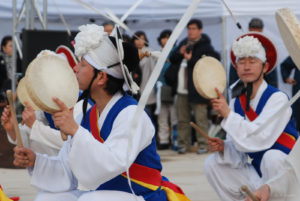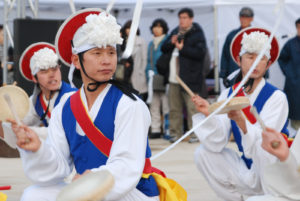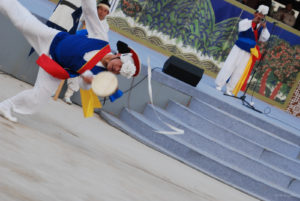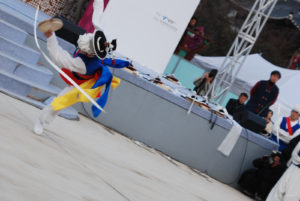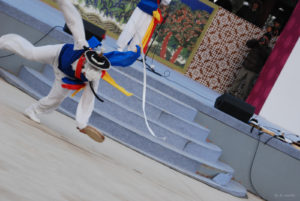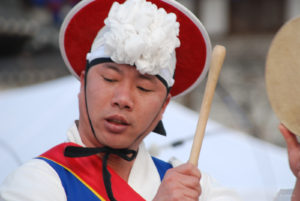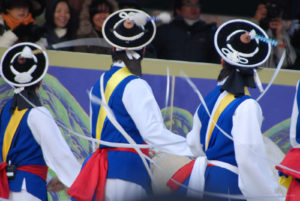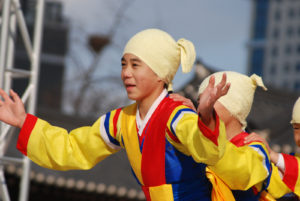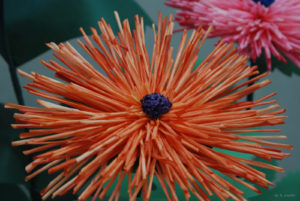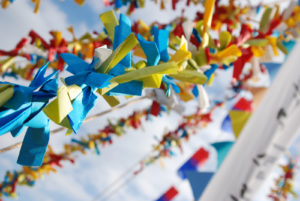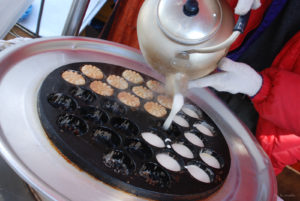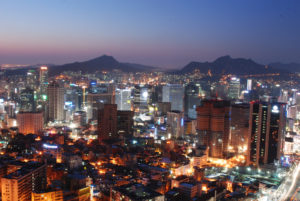South Korea – Gugak at the Lunar New Year

On the first day of the Lunar New Year I spent much of the day celebrating the occasion with many other South Koreans at the Namsangol Hanok Village. I heard the word “gugak” spoken, and eventually figured that it was referring to the traditional dance that would be performed later. I learned through research for this entry that “pungmul” is the actual name of the ribbon dance that so amazed me that day. Gugak is the general word for traditional Korean music.
The late morning of the New Year day basked in the gentle warmth of the winter sun. The Namsangol Hanok Village greeted visitors with all sorts of festivities. There were people everywhere, probably in the thousands. Many were playing traditional games. Celebratory delicacies at the food stalls attracted a large following, as long lines formed for the steaming rice cakes in seaweed soup. Children wearing hanbok gathered to play, and some sat at the stalls making handicrafts, such as traditional masks and origami. The paper crafts were beautiful. Some other children flew kites. The joyous atmosphere was contagious.
There was a wishing tree for the visitors. Ropes lined up in a conical shape like a Christmas tree. People gathered pieces of colorful writing paper and wrote down their wish, they then tied the wish onto the wishing tree. I did mine too, “I want to travel around the world!”
Came late afternoon and it was time to see the performance of traditional Korean dance. I seized a good spot with much anticipation. The pungmul is a tradition that had its roots in the farming culture of South Korea. It was often performed to accompany shamanistic rituals. [1] Also, it was a popular form of cultural expression during the colonial times.[2]
The dance opened with the din of drums and gongs, beating a rhythm that would set the cadence for the movement. Dressed in the national colors, the performance troupe entered the open stage with ribbons swirling above their hats. Accompanied by the constant movements of the dancers, the ribbons formed an amazing scene in the air, sometimes drawing circles, sometimes waving curves. One of the actors did a flip in mid-air, while his ribbon encircling around his body, and received wild applause. The group choreography was dazzling, to say the least.
I felt my heart racing as the acrobatics began. One by one, children threw each other up onto their shoulders to form a human tree, fully meeting the rhythmic beat in the background. Again the crowd applauded, and I clapped the hardest I could. I was so amazed by this dance that I felt my body warm from excitement.
Amidst the cheers of the crowd I observed the dancers themselves being completely absorbed in their performance. While they took pride in their art, the dancers in the spirited pungmul also created a cultural space that had an incredible power to engage my emotions as I watched. It was with the audience’s involvement that the cultural expression was complete.
The Lunar New Year festivities opened my eyes to another aspect of the Soul of Asia. Traditional crafts, foods and cultural performances are at the very heart of South Korea’s identity, and only at this time of the year would a tourist be able to observe and celebrate the traditions of South Korea with its people. I completed the day’s activities with a visit to the N’Seoul Tower. As I saw the neon-lit cityscape of Seoul, it being such a contrast to the festivities at Namsangol Hanok Village, I marveled at South Korea’s remarkable ability to preserve its traditions and yet accomplishing so much as a developed nation in modern times.
By this day, I have moved far beyond the few Korean dishes as the only thing that I knew about South Korea.
[2] Id.

